Diversity of Sources of Income for Smallholder Farming Communities in Malawi: Importance for Improved Livelihood
Abstract
:1. Introduction
2. Material and Methods
3. Results and Discussion
3.1. Crops and Vegetables Growing
3.2. Livestock Ownership, Sales of Livestock and Livestock Products
3.2.1. Livestock Sale
3.2.2. Livestock Product Sale
3.3. Important Sources of Income for Malawian Smallholder Farmers
3.4. Mean Income Comparison between LFs and FFs Producing Crops and Vegetables
3.5. Mean Income Comparison between LFs and FFs Producing Livestock
3.6. Mean Income Comparison between LFs and FFs Having Income from Other Sources
4. Conclusions
Author Contributions
Funding
Institutional Review Board Statement
Informed Consent Statement
Data Availability Statement
Acknowledgments
Conflicts of Interest
References
- Del Ninno, C.; Dorosh, P.A.; Subbarao, K. Food aid, domestic policy and food security: Contrasting experiences from South Asia and sub-Saharan Africa. Food Policy 2007, 32, 413–435. [Google Scholar] [CrossRef]
- Ellis, F.; Kutengule, M.; Nyasulu, A. Livelihoods and rural poverty reduction in Malawi. World Dev. 2003, 31, 1495–1510. [Google Scholar] [CrossRef]
- Lowder, S.K.; Skoet, J.; Raney, T. The number, size, and distribution of farms, smallholder farms, and family farms worldwide. World Dev. 2016, 87, 16–29. [Google Scholar] [CrossRef] [Green Version]
- Altieri, M.A.; Koohafkan, P. Enduring Farms: Climate Change, Smallholders and Traditional Farming Communities: Third World Network (TWN). 2008. Available online: http://agroeco.org/wp-content/uploads/2010/11/Enduring-farms.pdf (accessed on 2 July 2021).
- Otte, M.; Chilonda, P. Cattle and Small Ruminant Production Systems in Sub-Saharan Africa. A Systematic Review . Livestock Information Sector Analysis and Policy Branch, FAO Agriculture Department. 2002. Available online: http://www.fao.org/3/y4176e/y4176e.pdf (accessed on 10 July 2021).
- Singh, R.; Kumar, P.; Woodhead, T. Smallholder farmers in India: Food security and agricultural policy. RAP Publ. 2002, 3, 20–27. [Google Scholar]
- Klinedinst, P.L.; Wilhite, D.A.; Hahn, G.L.; Hubbard, K.G. The potential effects of climate change on summer season dairy cattle milk production and reproduction. Clim. Chang. 1993, 23, 21–36. [Google Scholar] [CrossRef] [Green Version]
- Frenken, K. Irrigation in Africa in Figures: AQUASTAT Survey, 2005: Food & Agriculture Organization. 2005. Available online: https://agris.fao.org/agris-search/search.do?recordID=SO2005100059 (accessed on 12 June 2021).
- O’Reilly, C.M.; Alin, S.R.; Plisnier, P.-D.; Cohen, A.S.; McKee, B.A. Climate change decreases aquatic ecosystem productivity of Lake Tanganyika, Africa. Nature 2003, 424, 766–768. [Google Scholar] [CrossRef] [PubMed]
- United Nations. World Population Prospects 2019. Available online: https://population.un.org/wpp/ (accessed on 19 May 2021).
- World Bank Data. World Bank Country and Lending Groups. Available online: https://datahelpdesk.worldbank.org/knowledgebase/articles/906519 (accessed on 19 May 2021).
- World Bbank. DataBank. Available online: https://databank.worldbank.org/home.aspx (accessed on 19 May 2021).
- Malawi. 2006. Available online: http://www.fao.org/ag/agp/agpc/doc/counprof/malawi/Malawi.htm (accessed on 14 November 2016).
- The UN NEWS Centre. Malawi Must Reassess Its Agricultural Policies to Break Cycle of Poverty 2013. Available online: http://www.un.org/apps/news/story.asp?NewsID=45467 (accessed on 12 July 2021).
- Banda, J.W. Revolutionalising the Livestock Industry in Malawi. In Proceedings of the 12th University of Malawi Inaugural Lecture, Crossroads Hotel, Lilongwe, Malawi, 7 November 2008. [Google Scholar]
- Menon, R. Famine in Malawi: Causes and Consequences. Occassion Paper Human Development Report Office. Available online: http://hdrundporg/en/reports/global/hdr2007-2008/papers/menon_roshni_2007a_malawipdf (accessed on 10 June 2021).
- You, L.; Ringler, C.; Wood-Sichra, U.; Robertson, R.; Wood, S.; Zhu, T. What is the irrigation potential for Africa? A combined biophysical and socio-economic approach. Food Policy 2011, 36, 770–782. [Google Scholar] [CrossRef] [Green Version]
- Morton, J.F. The impact of climate change on smallholder and subsistence agriculture. Proc. Natl. Acad. Sci. USA 2007, 104, 19680–19685. [Google Scholar] [CrossRef] [PubMed] [Green Version]
- Davis, K. Extension in sub-Saharan Africa: Overview and assessment of past and current models and future prospects. J. Int. Agric. Ext. Educ. 2008, 15, 15–28. [Google Scholar]
- Chabata, I.; de Wolf, J. The lead Farmer Approach: An Effective Way of Agricultural Technology Dissemination. International Centre Tropical Agriculture, Putting Nitrogen Fixation to Work for Smallholder Farmers in Africa. 2013. Available online: https://www.n2africa.org/sites/default/files/N2Africa%20Poster%20Isaac%20.pdf (accessed on 12 June 2021).
- Fisher, M.; Holden, S.T.; Thierfelder, C.; Katengeza, S.P. Awareness and adoption of conservation agriculture in Malawi: What difference can farmer-to-farmer extension make? Int. J. Agric. Sustain. 2018, 16, 310–325. [Google Scholar] [CrossRef]
- Regine, A. The Impact of the Lead Farmer Extension Approach Implemented by the Development Fund of Norway in Malawi; FNI Report 5/2019; Fridtjof Nansen Institute: Lysaker, Norway, 2019. [Google Scholar]
- Creative Research Systems. Sample Size Formulas for Our Sample Size Calculator. Available online: https://www.surveysystem.com/sample-size-formula.htm (accessed on 1 May 2020).
- Ragasa, C. Effectiveness of the lead farmer approach in agricultural extension service provision: Nationally representative panel data analysis in Malawi. Land Use Policy 2020, 99, 104966. [Google Scholar] [CrossRef]
- Holden, S.T.; Fisher, M.; Katengeza, S.P.; Thierfelder, C. Can lead farmers reveal the adoption potential of conservation agriculture? The case of Malawi. Land Use Policy 2018, 76, 113–123. [Google Scholar] [CrossRef]
- Ragasa, C. Modeling the Effectiveness of the Lead Farmer Approach in Agricultural Extension Service Provision: Nationally Representative Panel Data Analysis in Malawi: Intl Food Policy Res Inst; International Food Policy Research Institute: Washington, DC, USA, 2019. [Google Scholar]
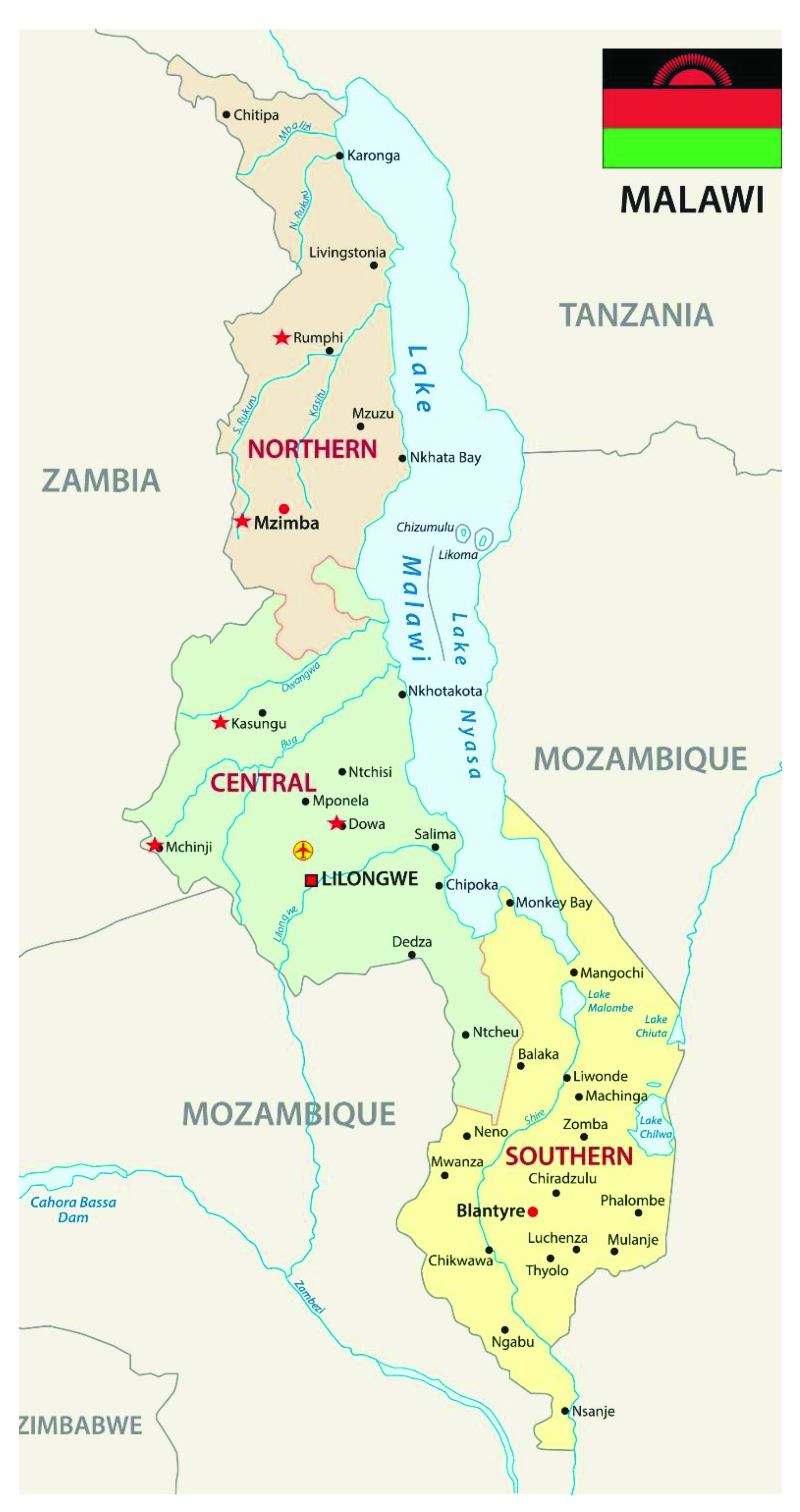
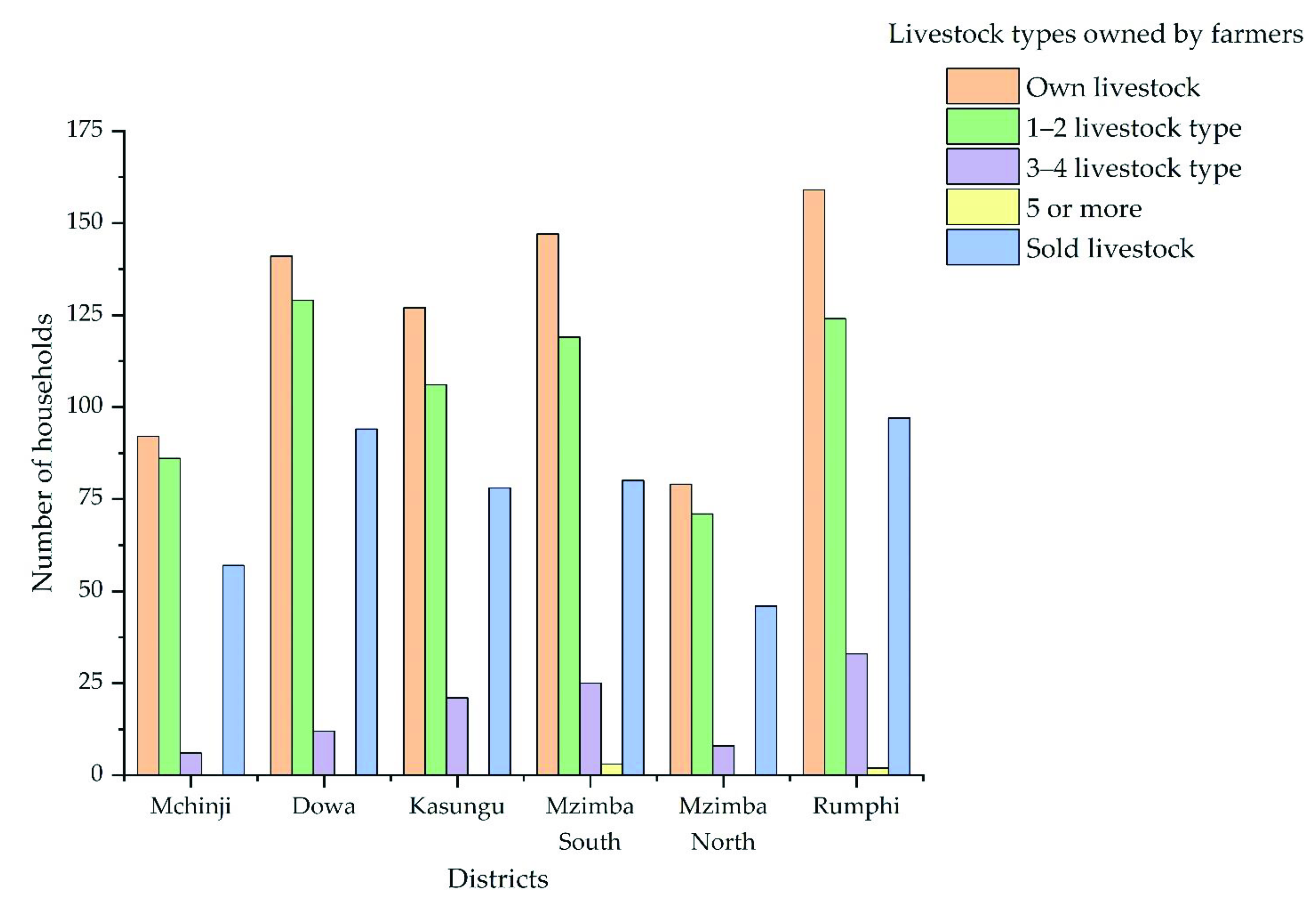
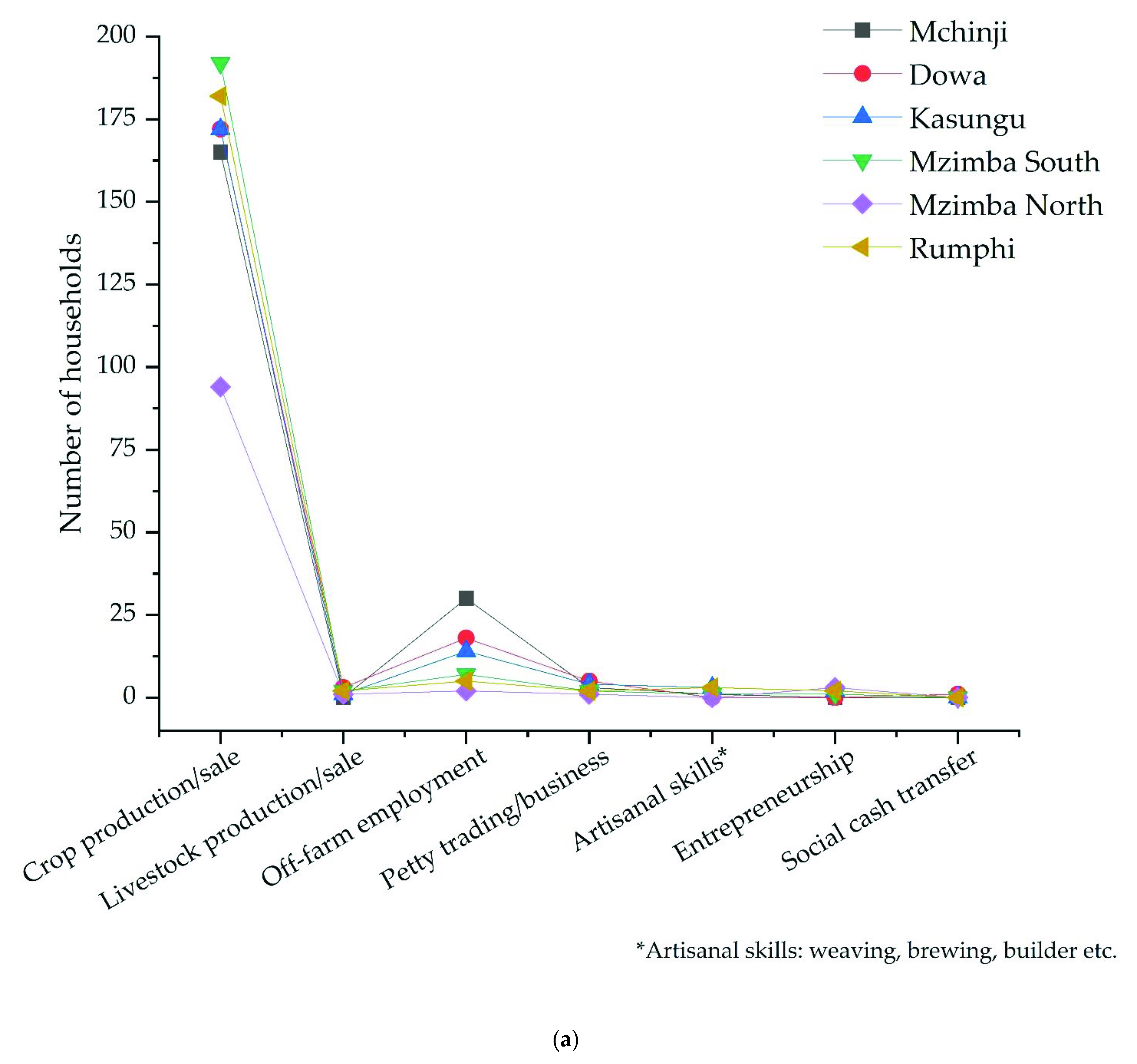
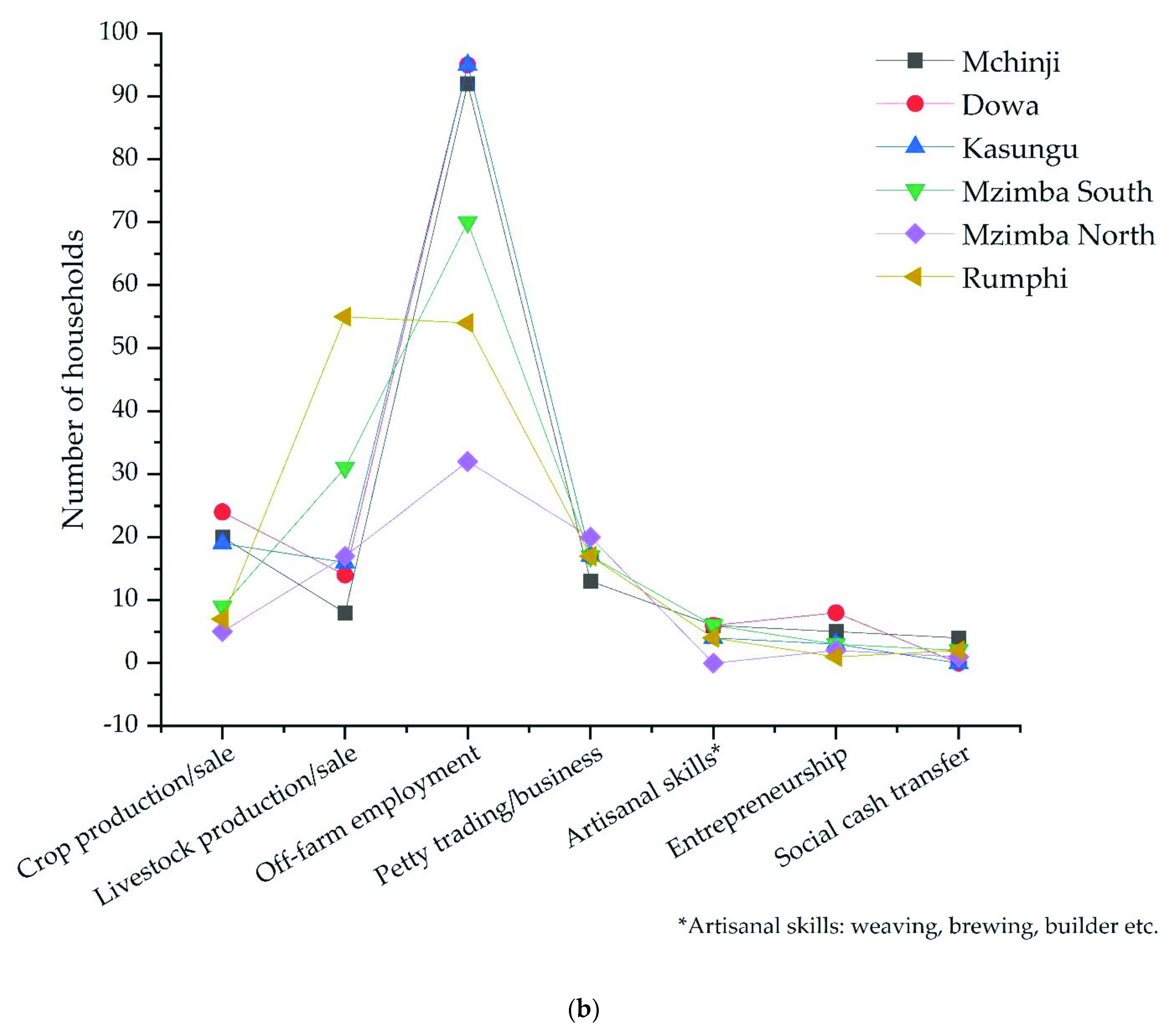

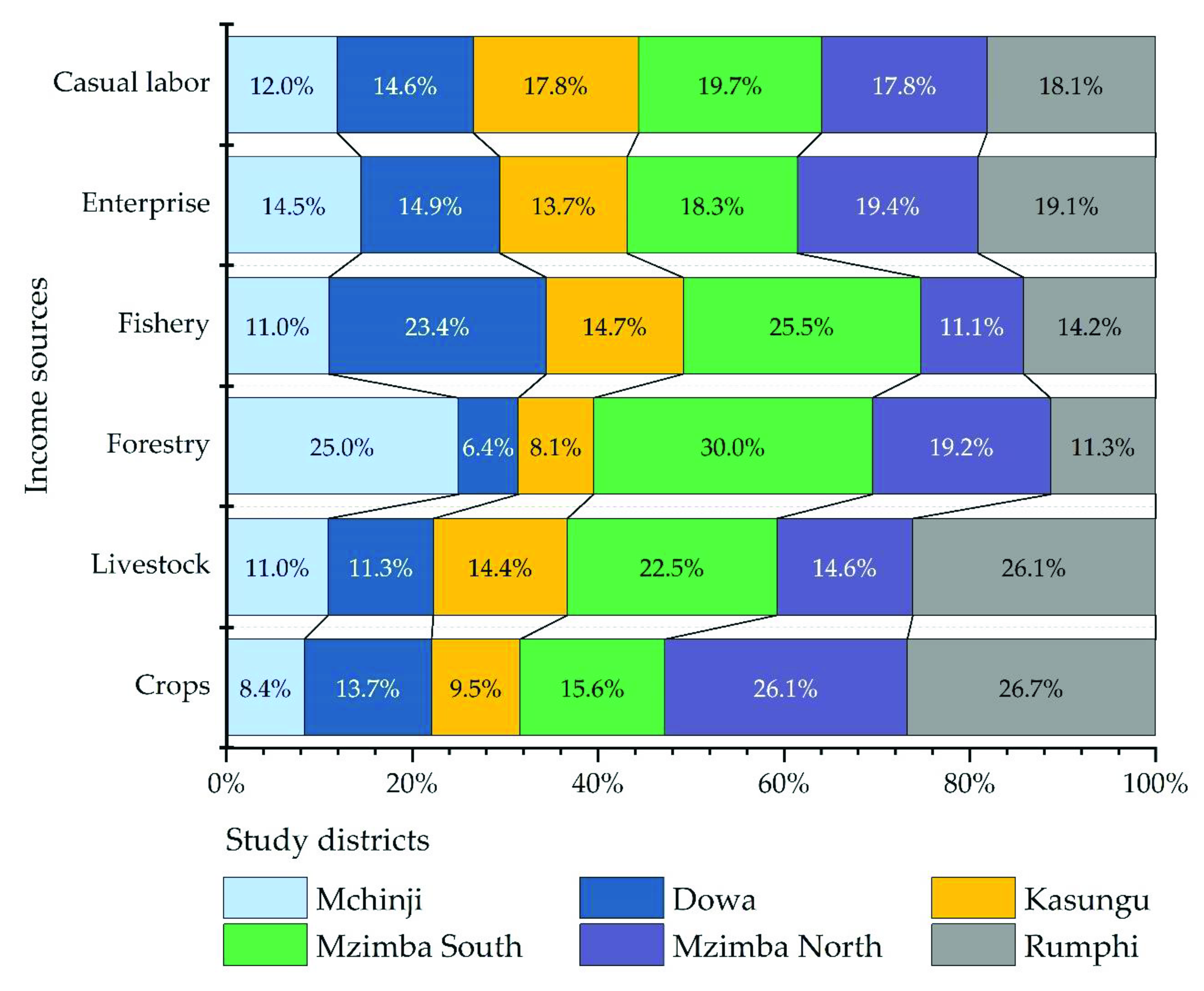

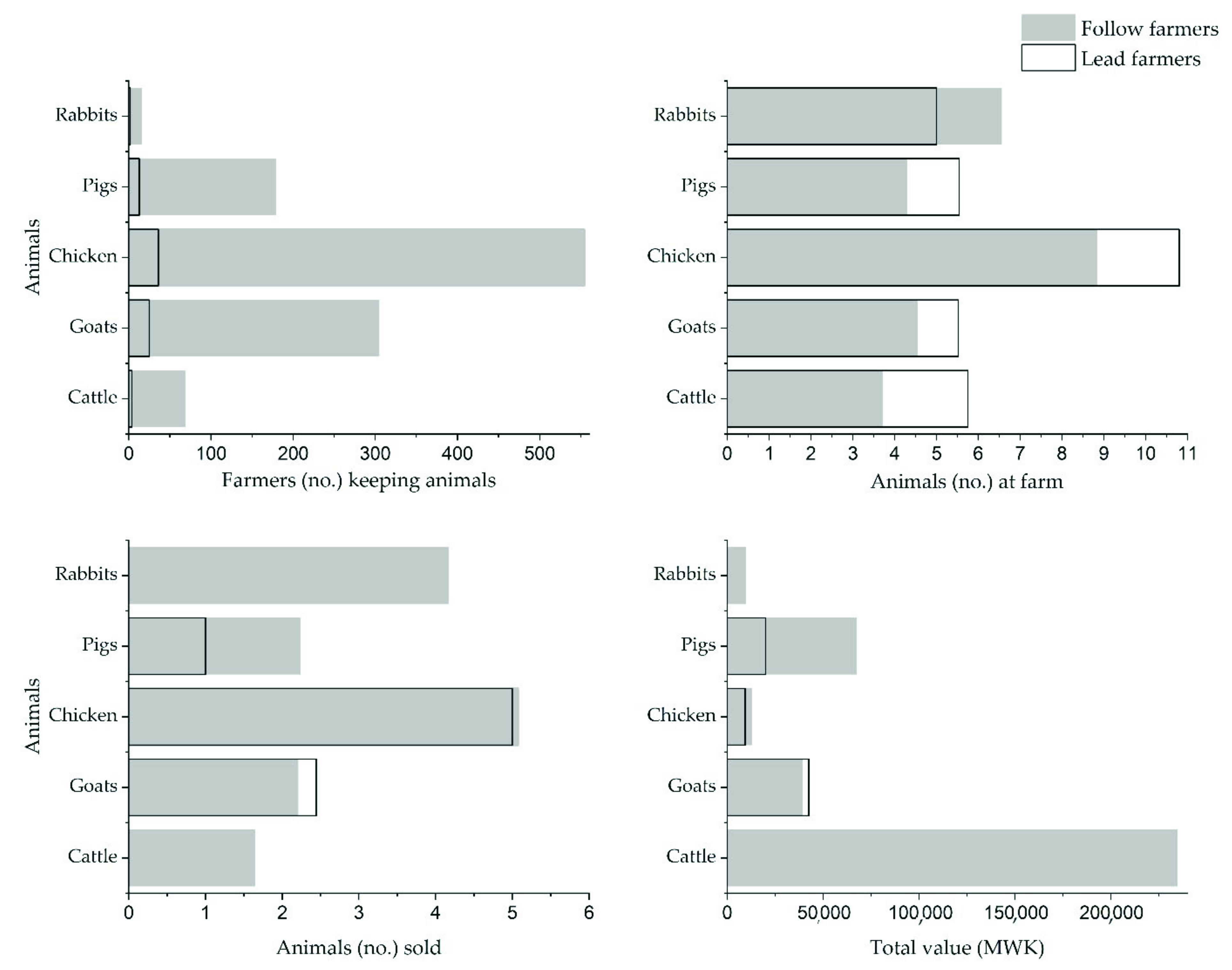
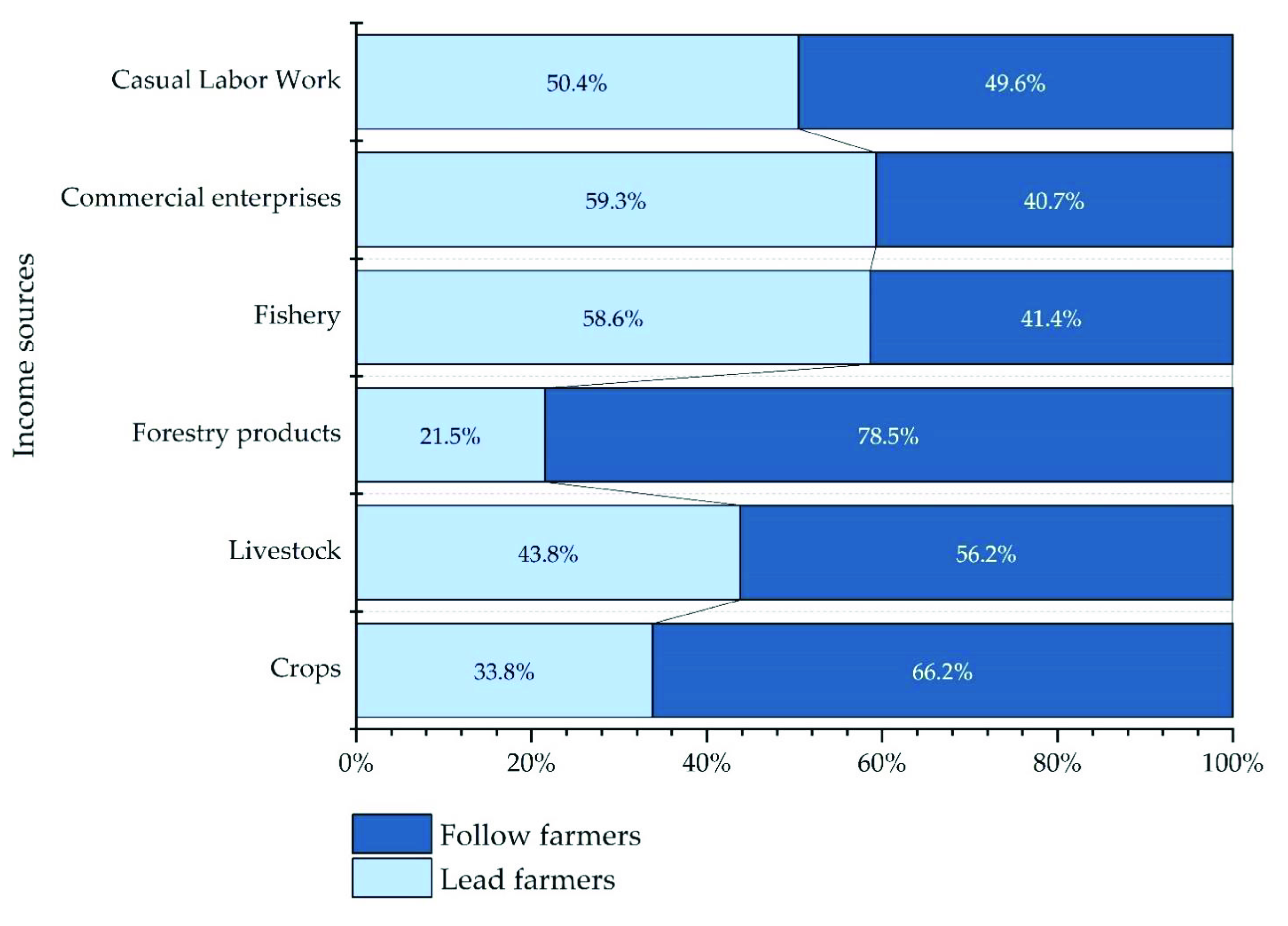
| District * | EPA | List of Sections in EPAs |
|---|---|---|
| Mchinji | Mkanda | Mkanda East, Mkanda North, Mkanda South, Mkanda Central |
| Kalulu | Kalulu, Chitunda, Mchakanga, Mchakanga, Kapiri South | |
| Dowa | Mndolera | Dzoole, Katchitsa, Lipili, Msese |
| Madisi | Katalima, Kalonga A, Madisi A, Madisi B | |
| Kasungu | Lisasadzi | Mponda West, Kasera, Kawamba North, Kawamba Central |
| Kaluluma | Chamakala East, Chamakala West, Kamwalembo, Kaluluma Central | |
| Mzimba South | Luwerezi | Luwerezi, Ngoli, Chirawegu, Mphazi |
| Champhira | Champhira Central, Chamanji, Luviri, Kaulusi | |
| Mzimba North | Engucwini | Engucwini, Emayaleni, Madise |
| Rumphi | Bolero | Bolero, Lundu, Jallira, Chirambo |
| Mhuju | Chimyanga, Phwamphwa, Mwakhunikira, Ng’onga |
| Description | All Districts | Mchinji | Dowa | Kasungu | Mzimba South | Mzimba North | Rumphi |
|---|---|---|---|---|---|---|---|
| Number | 1131 | 205 | 218 | 204 | 206 | 101 | 197 |
| Male | 468 | 81 | 95 | 91 | 70 | 37 | 94 |
| Female | 663 | 124 | 123 | 113 | 136 | 64 | 103 |
| Lead farms | 56 | 12 | 8 | 9 | 8 | 8 | 11 |
| Average land size (ha) | 2.7 | 2.5 | 2.8 | 2.9 | 3 | 2.3 | 2.7 |
| Hire labor | 211 | 23 | 36 | 35 | 41 | 20 | 56 |
| Grow crops and vegetables | |||||||
| Grow any crop | 1108 | 199 | 205 | 201 | 206 | 101 | 196 |
| Tobacco | 224 | 11 | 56 | 22 | 12 | 33 | 90 |
| Sugar cane | 15 | 1 | 3 | 4 | 3 | 2 | 2 |
| Groundnut | 488 | 116 | 120 | 78 | 28 | 52 | 94 |
| Soya | 578 | 89 | 105 | 139 | 143 | 47 | 55 |
| Beans | 102 | 6 | 5 | 5 | 56 | 6 | 24 |
| Maize | 1098 | 196 | 211 | 198 | 203 | 99 | 191 |
| Cassava | 32 | 3 | 1 | 1 | 13 | 3 | 11 |
| Irish potato | 53 | 3 | 2 | 0 | 45 | 1 | 2 |
| Sweet potato | 279 | 14 | 19 | 31 | 43 | 12 | 160 |
| Banana | 11 | 2 | 0 | 2 | 3 | 1 | 3 |
| Vegetables | 119 | 24 | 16 | 17 | 25 | 19 | 18 |
| Spice | 6 | 0 | 0 | 0 | 0 | 0 | 6 |
| Own livestock | |||||||
| Cattle | 73 | 8 | 7 | 11 | 23 | 2 | 22 |
| Goats | 330 | 44 | 69 | 53 | 53 | 38 | 73 |
| Sheep | 4 | 1 | 0 | 2 | 0 | 1 | 0 |
| Chicken | 590 | 59 | 115 | 104 | 117 | 64 | 131 |
| Pigs | 192 | 5 | 29 | 34 | 58 | 13 | 53 |
| Rabbits | 18 | 4 | 2 | 5 | 1 | 4 | 2 |
| Sell products (livestock and forest) | |||||||
| Milk | 6 | 0 | 2 | 1 | 2 | 0 | 1 |
| Meat | 7 | 1 | 0 | 0 | 1 | 2 | 3 |
| Eggs | 16 | 2 | 5 | 3 | 1 | 1 | 4 |
| Timber | 17 | 5 | 2 | 1 | 4 | 1 | 4 |
| Poles | 16 | 4 | 4 | 2 | 1 | 0 | 5 |
| Firewood | 56 | 5 | 18 | 12 | 11 | 6 | 4 |
| Honey | 2 | 0 | 0 | 0 | 1 | 0 | 1 |
| Mushroom | 3 | 1 | 0 | 1 | 1 | 0 | 0 |
| Number of Farmers | Mchinji | Dowa | Kasungu | Mzimba South | Mzimba North | Rumphi | TOTAL |
|---|---|---|---|---|---|---|---|
| Farmers owning livestock | 92 | 141 | 127 | 147 | 79 | 159 | 745 |
| 1–2 livestock types | 86 | 129 | 106 | 119 | 71 | 124 | 635 |
| 3–4 livestock types | 6 | 12 | 21 | 25 | 8 | 33 | 105 |
| 5 or more | 0 | 0 | 0 | 3 | 0 | 2 | 5 |
| Farmers selling livestock | 57 | 94 | 78 | 80 | 46 | 97 | 452 |
| Types of livestock | |||||||
| Farmers owning cattle | 8 | 7 | 11 | 23 | 2 | 22 | 73 |
| Number owned (average) | 1.9 | 2.9 | 2.6 | 3.8 | 5.0 | 5.5 | 3.6 |
| Sale of cattle | 2 | 5 | 6 | 15 | 2 | 17 | 47 |
| Number of cattle sold (average) | 1.0 | 1.0 | 3.0 | 1.6 | 2.0 | 1.7 | 1.7 |
| Total Value (MWK) | 190,000 | 111,750 | 240,000 | 262,000 | 520,000 | 249,571 | 262,220 |
| Farmers owning goats | 44 | 67 | 53 | 53 | 38 | 73 | 328 |
| Number owned | 3.9 | 3.6 | 4.0 | 4.7 | 5.1 | 6.2 | 4.6 |
| Sale of goats | 34 | 52 | 39 | 37 | 28 | 54 | 244 |
| Number of goats sold (average) | 1.7 | 2.1 | 2.3 | 2.1 | 2.4 | 2.7 | 2.2 |
| Total Value (MWK) | 31,344 | 31,500 | 38,437 | 36,703 | 46,684 | 53,500 | 39,695 |
| Farmers owning chickens (broiler) | 59 | 109 | 104 | 117 | 64 | 131 | 584 |
| Number owned (average) | 8.3 | 7.7 | 7.4 | 9.5 | 8.0 | 11.6 | 8.7 |
| Sale of chickens | 37 | 77 | 62 | 63 | 38 | 79 | 356 |
| Number of chickens sold (average) | 4.5 | 5.3 | 4.7 | 5.4 | 4.9 | 5.3 | 5.0 |
| Total Value (MWK) | 9616 | 8619 | 9854 | 22,894 | 11,017 | 14,583 | 12,764 |
| Farmers owning pigs | 5 | 27 | 34 | 58 | 13 | 53 | 190 |
| Number owned (average) | 1.6 | 2.3 | 4.6 | 5.0 | 2.9 | 5.3 | 3.6 |
| Sale of pigs | 5 | 20 | 28 | 33 | 6 | 31 | 123 |
| Number of pigs sold (average) | 4.3 | 1.8 | 1.6 | 2.7 | 1.3 | 2.1 | 2.3 |
| Total Value (MWK) | 74,666 | 36,555 | 47,461 | 93,695 | 24,666 | 65,181 | 57,037 |
| Income Source | Mchinji | Dowa | Kasungu | Mzimba South | Mzimba North | Rumphi | All Districts | |
|---|---|---|---|---|---|---|---|---|
| Crops | Mean | 80,923 a | 131,476 ab | 91,658 a | 149,767 ab | 250,881 bc | 257,138 c | 151,688 |
| SD | 215,411 | 326,323 | 140,433 | 293,269 | 776,823 | 456,820 | 378,396 | |
| (n) | 199 | 205 | 201 | 206 | 101 | 196 | 1108 | |
| Livestock | Mean | 19,409 a | 19,934 a | 25,460 a | 39,777 a | 25,848 a | 46,159 a | 30,956 |
| SD | 50,549 | 30,112 | 63,419 | 106,467 | 65,875 | 113,594 | 81,850 | |
| (n) | 93 | 141 | 127 | 147 | 79 | 160 | 747 | |
| Forestry | Mean | 35,152 a | 9050 a | 11,412 a | 42,215 a | 26,971 a | 15,941 a | 24,028 |
| SD | 118,112 | 16,332 | 17,432 | 70,876 | 16,866 | 22346 | 66,070 | |
| (n) | 25 | 24 | 16 | 22 | 7 | 17 | 111 | |
| Fishery | Mean | 171,000 a | 362,000 a | 227,983 a | 394,933 a | 172,400 a | 219,600 a | 260,233 |
| SD | 131,256 | 285,926 | 306,643 | 494,390 | 92,955 | 169,119 | 289,992 | |
| (n) | 13 | 10 | 12 | 9 | 5 | 6 | 55 | |
| Enterprise (small business) | Mean | 120,660 a | 124,266 a | 113,518 a | 152,400 a | 161,422 a | 158,986 a | 136,586 |
| SD | 196,437 | 179,733 | 145,886 | 233,967 | 213,949 | 194,028 | 193,008 | |
| (n) | 46 | 67 | 56 | 53 | 35 | 51 | 308 | |
| Casual labor | Mean | 25,871 a | 31,632 ab | 38,418 a | 42,619 b | 38,516 ab | 39,254 ab | 35,058 |
| SD | 26,988 | 31376 | 45,579 | 62246 | 46,009 | 68,212 | 46,888 | |
| (n) | 156 | 156 | 143 | 116 | 61 | 95 | 727 | |
| Total | Mean | 149,488 a | 228,590 ab | 178,559 a | 263,124 abc | 360,704 bc | 387,934 c | 351,333 |
| SD | 266,924 | 380,601 | 224,569 | 415,698 | 802,816 | 579,443 | 452,026 | |
| (n) | 205 | 205 | 204 | 206 | 101 | 197 | 1118 |
| Product | Lead Farmer ± SD (n) | Follow Farmer ± SD (n) | p-Value |
|---|---|---|---|
| Crops | |||
| Groundnuts | 49,575 ± 109,287 (26) | 31,009 ± 45,919 (457) | 0.3968 |
| Irish potato | 87,375 ± 121,445 (2) | 62,344 ± 94,587 (51) | 0.8197 |
| Maize | 35,687 ± 83,814 (56) | 15,669 ± 62,669 (1033) | 0.0835 |
| Soya beans | 44,501 ± 46,962 (41) | 40,630 ± 57,737 (533) | 0.6195 |
| Spice | NA | 82,700 ± 117,608 (6) | NA |
| Sugarcane | 50,000 ± NA (1) | 48,485 ± 63,575 (14) | NA |
| Sweet potato | 15,294 ± 28,964 (17) | 1,283,652 ± 26,249 (141) | 0.7422 |
| Tobacco | 649,007 ± 730,522 (13) | 395,033 ± 682,512 (207) | 0.2434 |
| Other crops * | 49,206 ± 128,413 (30) | 41,477 ± 110,432 (304) | 0.7523 |
| Livestock | |||
| Eggs | 500 ± NA (1) | 12,880 ± 28,893 (15) | NA |
| Meat | 120,000 ± NA (1) | 115,166 ± 93,317 (6) | NA |
| Milk | NA | 260,950 ± 241,782 (5) | NA |
| Cattle | NA | 234,700 ± 140,262 (20) | NA |
| Chickens | 9433 ± 13,806 (21) | 13,026 ± 26,441 (248) | 0.3049 |
| Goats | 42,611 ± 35,298 (18) | 39,455 ± 38,165 (178) | 0.7233 |
| Pigs | 20,000 ± 7071 (2) | 67,614 ± 99,888 (70) | 0.0009 |
| Other livestock ** | 7000 ± 5656 (2) | 7666 ± 6146 (15) | 0.8970 |
| Forestry products | |||
| Firewood | 7650 ± 3457 (4) | 14,688 ± 17,320 (51) | 0.0276 |
| Mushroom | NA | 56,300 ± 65,010 (4) | NA |
| Poles | 15,250 ± 10,253 (2) | 7592 ± 8874 (13) | 0.4725 |
| Seedlings | 10,000 ± NA (1) | 28,187 ± 41,629 (4) | NA |
| Timber | 1600 ± 282 (2) | 72,266 ± 164,966 (15) | 0.1193 |
| Other forestry *** | 1500 ± NA (1) | 8508 ± 5176 (12) | NA |
| Fishery | |||
| Fish sales | 340,000 ± 197,989 (2) | 203,200 ± 123,904 (3) | 0.4986 |
| Fish vending | 298,850 ± 347,695 (8) | 247,265 ± 292,878 (12) | 0.7025 |
| Commercial enterprises | |||
| Artwork | 62,500 ± 24,748 (2) | 115,469 ± 16,2000 (3) | 0.1860 |
| Barbershop | NA | 151,000 ± 105,090 (4) | NA |
| Beer brewing | 269,000 ± 26,870 (2) | 75,247 ± 102,006 (36) | 0.0038 |
| Grocery business | 215,000 ± 177,974 (3) | 256,030 ± 296,670 (26) | 0.7483 |
| Petty trading | 115,633 ± 46,671 (3) | 98,959 ± 81,400 (44) | 0.6138 |
| Value-added products | 172,412 ± 203,048 (10) | 86,262 ± 119,171 (89) | 0.2182 |
| Others **** | 307,500 ± 466,413 (4) | 152,410 ± 218,057 (84) | 0.5546 |
| Casual laboring work | |||
| Laboring Work | 35,716 ± 48,514 (30) | 35,079 ± 46,867 (696) | 0.9443 |
| Number of sources | 6 ± 2 (56) | 4 ± 1 (1062) | <0.0001 |
| Total income | 469,342 ± 594,435 (56) | 239,837 ± 440,628 (1062) | 0.0006 |
Publisher’s Note: MDPI stays neutral with regard to jurisdictional claims in published maps and institutional affiliations. |
© 2021 by the authors. Licensee MDPI, Basel, Switzerland. This article is an open access article distributed under the terms and conditions of the Creative Commons Attribution (CC BY) license (https://creativecommons.org/licenses/by/4.0/).
Share and Cite
Bhatti, M.A.; Godfrey, S.S.; Ip, R.H.L.; Kachiwala, C.; Hovdhaugen, H.; Banda, L.J.; Limuwa, M.; Wynn, P.C.; Ådnøy, T.; Eik, L.O. Diversity of Sources of Income for Smallholder Farming Communities in Malawi: Importance for Improved Livelihood. Sustainability 2021, 13, 9599. https://doi.org/10.3390/su13179599
Bhatti MA, Godfrey SS, Ip RHL, Kachiwala C, Hovdhaugen H, Banda LJ, Limuwa M, Wynn PC, Ådnøy T, Eik LO. Diversity of Sources of Income for Smallholder Farming Communities in Malawi: Importance for Improved Livelihood. Sustainability. 2021; 13(17):9599. https://doi.org/10.3390/su13179599
Chicago/Turabian StyleBhatti, Muhammad Azher, Sosheel Solomon Godfrey, Ryan H. L. Ip, Chipo Kachiwala, Håvard Hovdhaugen, Liveness J. Banda, Moses Limuwa, Peter C. Wynn, Tormod Ådnøy, and Lars Olav Eik. 2021. "Diversity of Sources of Income for Smallholder Farming Communities in Malawi: Importance for Improved Livelihood" Sustainability 13, no. 17: 9599. https://doi.org/10.3390/su13179599
APA StyleBhatti, M. A., Godfrey, S. S., Ip, R. H. L., Kachiwala, C., Hovdhaugen, H., Banda, L. J., Limuwa, M., Wynn, P. C., Ådnøy, T., & Eik, L. O. (2021). Diversity of Sources of Income for Smallholder Farming Communities in Malawi: Importance for Improved Livelihood. Sustainability, 13(17), 9599. https://doi.org/10.3390/su13179599








